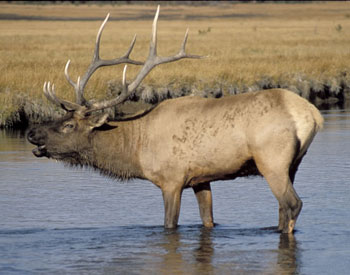 Size. Cow elk can weigh more than 500 pounds; the average bull weighs around 800 pounds.
Size. Cow elk can weigh more than 500 pounds; the average bull weighs around 800 pounds.
Antlers. Antlers, which only grow on bulls, are shed every Spring. These are made of fast-growing bone -- so fast, in fact, that scientists think studying antlers may reveal clues about many types of cancer. Antlers can grow up to an inch a day! Contrary to what most people think, the number of branches or points does not signify an animals' age. Elk will frequently polish their antlers on trees, leaving tell-tale "rubs" -- areas of trees about four feet off the ground scraped bare of bark.
Nomenclature. Their native name is “wapiti” meaning white rump. It means "white rump." In Europe, the word "elk" more often refers to the animal we Americans call a moose.
Family Life. To protect elk calves from predators, a cow will hide her newborn in a log or shrub, or among tall grasses, for the first few weeks of its life. The calves wear camouflaging white spots and have very little scent, which helps keep them hidden from predators. To avoid leading predators to her calf, the cow keeps watch from a safe distance, visiting only periodically during the day to let it nurse. Cows are vigilant, however, and will chase off any predators that get too close, using her powerful front hooves as weapons. After a few weeks, the calves have grown strong enough to keep up and will join the rest of the herd.
Home Lands Elk once ranged as far south as Mexico and as far east as the Carolinas. Unregulated hunting and habitat loss pushed elk to the edge of extinction; by the late 1800s, populations could only be found in remote areas of the west. They are native to Ontario, Canada.
Elk Fast Facts
- Elk have an average lifespan of 8 to 12 years in the wild.
- An elk group is called a gang.
- Elk males are called bulls.
- Elk males are called bulls; females are called cows, and babies are called calves.
- Elk females do not grow antlers.
- Elk are smaller than moose.
- Elks are strong swimmers.
- Elk belong to the deer family, also known as cervidae. Other members of the cervidae family are moose, caribou, white-tailed deer and mule deer. All these species have the common trait of an even number of toes.
- Elk are intelligent - protection of their young against dogs and coyotes comes naturally!
- Cows can breed at 18 months of age and will breed up to 15 years of age, some even up to 20 years
- Cows pregnancy will last between 245-255 days and some as late as 270 days
- Elk calves are normally born in May or June with white spots and a tan rump. Twins are very rare.
- In their first year of life, a calf will gain over 300 lbs!
- Antlers can grow from 1 in. to 1½ inch in just a single day. The amount of antler growth is regulated by the length of daylight
- As the antler grows, it is soft with a hair-like covering called velvet.
In the first 75 days of growth, a domestic elk may produce as much as 20 to 40 pounds of new antler tissue - Elk velvet has been used in traditional remedies for centuries.
- Elk meat promotes a flavorful, fat free & low cholesterol, diet.
